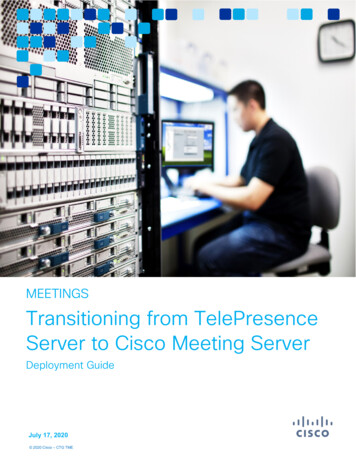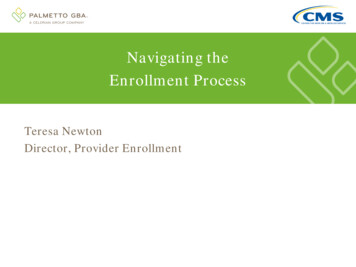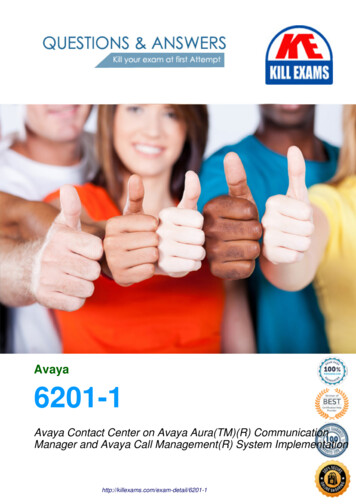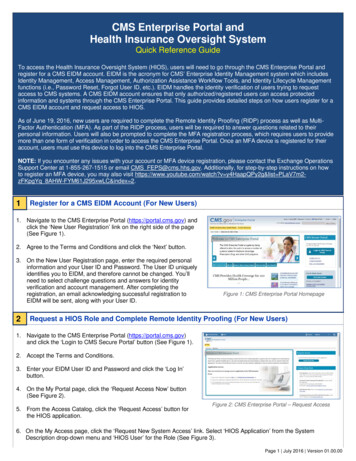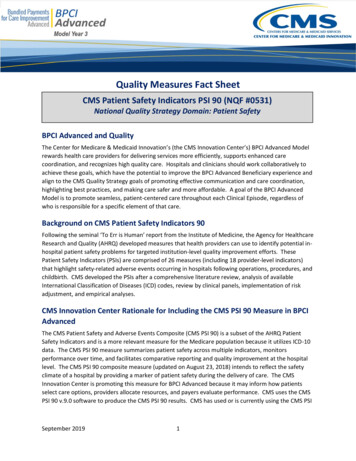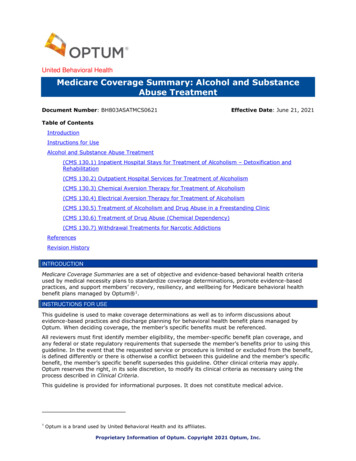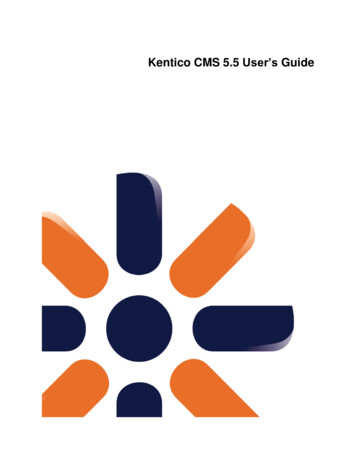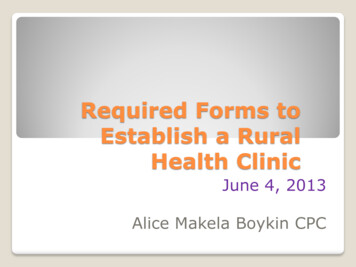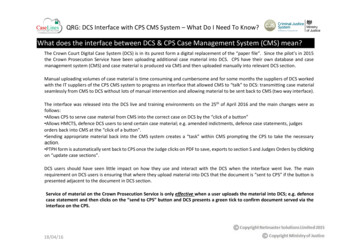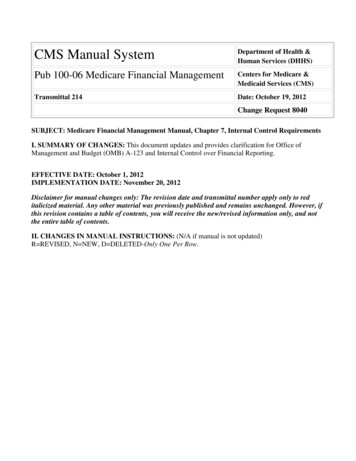
Transcription
CMS Manual SystemDepartment of Health &Human Services (DHHS)Pub 100-06 Medicare Financial ManagementCenters for Medicare &Medicaid Services (CMS)Transmittal 214Date: October 19, 2012Change Request 8040SUBJECT: Medicare Financial Management Manual, Chapter 7, Internal Control RequirementsI. SUMMARY OF CHANGES: This document updates and provides clarification for Office ofManagement and Budget (OMB) A-123 and Internal Control over Financial Reporting.EFFECTIVE DATE: October 1, 2012IMPLEMENTATION DATE: November 20, 2012Disclaimer for manual changes only: The revision date and transmittal number apply only to reditalicized material. Any other material was previously published and remains unchanged. However, ifthis revision contains a table of contents, you will receive the new/revised information only, and notthe entire table of contents.II. CHANGES IN MANUAL INSTRUCTIONS: (N/A if manual is not updated)R REVISED, N NEW, D DELETED-Only One Per Row.
R/N/DCHAPTER / SECTION / SUBSECTION / TITLER7/20/CMS Contractor Internal Control Review Process and TimelineR7/20.1/Risk AssessmentR7/20.1.1/Risk Analysis ChartR7/30.1/Certification Package for Internal Controls (CPIC) RequirementsR7/30.1.1/OMB Circular A-123, Appendix A: Internal Controls Over FinancialReporting (ICOFR)R7/30.5/CPIC - Report of Internal Control DeficienciesR7/30.6/Definitions of Control Deficiency, Significant Deficiency, and MaterialWeaknessR7/30.7/Material Weaknesses Identified During the Reporting PeriodR7/30.8/Statement on Standards for Attestation Engagements (SSAE) Number 16,Reporting on Controls at Service ProvidersR7/40/Corrective Action PlansR7/40.1/Submission, Review, and Approval of Corrective Action PlansR7/40.2/Corrective Action Plan (CAP) ReportsR7/40.3/CMS Finding NumbersR7/50/List of CMS Contractor Control ObjectivesIII. FUNDING:For Fiscal Intermediaries (FIs), Regional Home Health Intermediaries (RHHIs) and/or Carriers:No additional funding will be provided by CMS; Contractors activities are to be carried out with theiroperating budgetsFor Medicare Administrative Contractors (MACs):The Medicare Administrative contractor is hereby advised that this constitutes technical direction asdefined in your contract. CMS does not construe this as a change to the MAC statement of Work. Thecontractor is not obliged to incur costs in excess of the amounts allotted in your contract unless and untilspecifically authorized by the Contracting Officer. If the contractor considers anything provided, asdescribed above, to be outside the current scope of work, the contractor shall withhold performance onthe part(s) in question and immediately notify the Contracting Officer, in writing or by e-mail, andrequest formal directions regarding continued performance requirements.IV. ATTACHMENTS:Business Requirements
Manual Instruction*Unless otherwise specified, the effective date is the date of service
Attachment - Business RequirementsPub. 100-06Transmittal: 214Date: October 19, 2012Change Request: 8040SUBJECT: Medicare Financial Management Manual, Chapter 7, Internal Control RequirementsEFFECTIVE DATE: October 1, 2012IMPLEMENTATION DATE: November 20, 2012I.GENERAL INFORMATIONA. Background: The Federal Managers’ Financial Integrity Act of 1982 (FMFIA) establishedinternal control requirements that shall be met by Federal agencies. For CMS to meet the requirementsof FMFIA, Medicare contractors shall demonstrate that they comply with FMFIA.B. Policy: The CMS contract with its Medicare contractors includes an article titled FMFIA. In thisarticle, the Medicare contractor agrees to cooperate with CMS in the development of procedurespermitting CMS to comply with FMFIA, and other related standards prescribed by the ComptrollerGeneral of the United States. Under various provisions of the Social Security Act and the MedicarePrescription Drug, Improvement, and Modernization Act of 2003 (MMA), Medicare contractors are tobe evaluated by CMS on administrative service performance. The CMS evaluates Medicare contractor’sperformance by various internal and external audits and reviews.II.BUSINESS REQUIREMENTS TABLEUse "Shall" to denote a mandatory requirement.NumberRequirement8040.1In the initial SSAE 16 audit (for new MACs,which include cases where outgoing MACstransition to a new MAC), all contractors shallinclude all of the CMS Control Objective areasdescribed in Section 50 of the IOM.8040.2For the SSAE 16 Entrance Conference, allMACs/DME MACs shall notify the individualResponsibilityA/B D FMAC M IEP Pa a Mr r Att CA BX XXX XXCARRIERRSharedOtherHSystemH MaintainersI F M V CI C M WS S S FS
Business Function Leads (BFLs), COR, andTechnical Monitors (TMs) via email, as well as,the A-123 Technical Team (ATT) atinternalcontrols@cms.hhs.gov of the date andtime of the entrance conference at least five daysprior to its occurrence.8040.3For the SSAE 16 Status Meetings, allMACs/DME MACs shall notify the BFLs, COR,TMs and ATT of the dates and times of the statusmeetings at least five days prior to theiroccurrence. The MAC/DME MAC shall providea copy of the written status report outliningactivities performed during the period prior to thestatus meeting (including CAP Follow Upactivities, if applicable), any significantfindings/potential issues identified thus far, andany concerns that may affect the completion ofthe work.X XX8040.4For the SSAE 16 Exit Conference, allMACs/DME MACs shall notify the BFLs, COR,TMs and ATT of the date and time of the exitconference at least five days prior to itsoccurrence.X XX8040.5All MACs/DME MACs shall provide copies ofthe draft SSAE 16 and CAP Follow Up reports toCMS by June 15th. These documents shall besubmitted electronically to the CMS InternalControl Team at internalcontrols@cms.hhs.gov,as well as to the BFLs, COR, and TMs. Thetarget date for CMS comments back to thecontractor is one week subsequent to issuance ofthe draft reports.X XX8040.6All contractors shall ensure that Provider CostReports are submitted in accordance with CMS'regulations, policies, and instructions.X8040.7All contractors shall ensure that HITECHincentive payments for Medicare subsection (d)and critical access hospitals are calculatedproperly, in accordance with CMS' regulations,policies, and instructions.X XXXX X X
III.PROVIDER EDUCATION D F C RM I A HER HR IMIAECROtherA BNoneIV.SUPPORTING INFORMATIONSection A: Recommendations and supporting information associated with listed requirements:N/AUse "Should" to denote a ns or other supporting information:NoneSection B: All other recommendations and supporting information: N/AV. CONTACTSPre-Implementation Contact(s): Ronald Dea, 410-786-1375 or Ronald.Dea@cms.hhs.gov, EleanorSheain, 410-786-8120 or Eleanor.Sheain@cms.hhs.govPost-Implementation Contact(s): Contact your Contracting Officer's Representative (COR) orContractor Manager, as applicable.VI. FUNDINGSection A: For Fiscal Intermediaries (FIs), Regional Home Health Intermediaries (RHHIs), and/orCarriers:No additional funding will be provided by CMS; Contractors activities are to be carried out with theiroperating budgets
Section B: For Medicare Administrative Contractors (MACs):The Medicare Administrative Contractor is hereby advised that this constitutes technical direction asdefined in your contract. CMS do not construe this as a change to the MAC Statement of Work. Thecontractor is not obligated to incur costs in excess of the amounts allotted in your contract unless anduntil specifically authorized by the Contracting Officer. If the contractor considers anything provided, asdescribed above, to be outside the current scope of work, the contractor shall withhold performance onthe part(s) in question and immediately notify the Contracting Officer, in writing or by e-mail, andrequest formal directions regarding continued performance requirements.
Medicare Financial Management ManualChapter 7 - Internal Control RequirementsTable of Contents(Rev.214)Transmittals for Chapter 720 - CMS Contractor Internal Control Review Process and Timeline20.1 - Risk Assessment20.1.1 - Risk Analysis Chart30.1 - Certification Package for Internal Controls (CPIC) Requirements30.1.1 – OMB Circular A-123 Appendix A: Internal Control Over Financial Reporting (ICOFR)30.5 - CPIC- Report of Internal Control Deficiencies30.6 - Definitions of Control Deficiency, Significant Deficiency, and Material Weaknesses30.7 – Material Weaknesses Identified During the Reporting Period30.8 – Statement on Standards for Attestation Engagements (SSAE) Number 16 (SSAE 16),Reporting on Controls at Service Providers40 - Corrective Action Plans40.1 - Submission, Review, and Approval of Corrective Action Plans40.2 - Corrective Action Plan (CAP) Reports40.3 - CMS Finding Numbers50 - List of CMS Contractor Control Objectives
20 - CMS Contractor Internal Control Review Process and Timeline(Rev.214, Issued: 10-19-12, Effective 10-01-12, Implementation: 11-20-12)NOTE: The CMS timeline is provided as a guide and is not considered absolute. Contractors may usethe guideline as a reference.Fiscal Year Calendar of Events and ActivitiesMONTHOCTOBERACTIVITY Release Certification Package for Internal Controls (CPIC) Updatefor period July – September Due: Within Five business days after September 30 NOVEMBER Review updated IOM to evaluate changes required to your systemof operationsUpdate Standard Operating ProceduresDECEMBER Incorporate updated IOM changesConduct risk assessment, see Section 20.1 Prepare Statement on Standards for Attestation Engagements(SSAE) Number 16 (SSAE 16) Statement of Work for the audit(MAC & DME MAC)Award SSAE 16 contract (MAC & DME MAC)JANUARY FEBRUARYMARCHAPRILMAYJUNE JULYAUGUST SEPTEMBER Update and submit A-123 cycle memos to CMS central officefifteen business days after December 31. See section 30.1.1.Conduct A-123 Risk Assessment, Section 30.1.1Prepare for A-123 review or SSAE 16 audit onsite reviewsUpdate CPIC Report of Internal Control Deficiencies, Section 30.5Begin preparing CPIC for all geographical locations, Section 30.3Draft Assurance Statement; Prepare to submit CAP, Sections 30.2 &40Submit CPIC for period October - JuneSubmit Corrective Action Plans CAPs, Section 40.1Due: 45 days after final A-123 and/or SSAE 16 ReportsDetermine if new material weaknesses were identified since theinterim CPIC report in July
20.1 - Risk Assessment(Rev.214, Issued: 10-19-12, Effective 10-01-12, Implementation: 11-20-12)Risk assessment identifies areas that should be reviewed to determine which components of anorganization's operation present the highest probability of waste, loss, or misappropriation. The riskassessment process is the identification, measurement, prioritization, and mitigation of risks. Thisprocess is intended to provide the contractors with: Direction for what areas should get priority attention from management due to the nature,sensitivity, and importance of the area's operations; A preliminary judgment from managers about the adequacy of existing internal control policiesand procedures to minimize or detect problems; and An early indication of where potential internal control weaknesses exist that should be corrected.The CMS requires contractors to perform an annual risk assessment, to identify the most critical areasand areas of greatest risk to be subjected to a review. Operational managers with knowledge andexperience in their particular business area shall perform risk assessments. Outside sources can assistwith this process, but should not be solely relied upon (e.g., Internal Audit departments, SSAE 16 audits,OMB Circular A-123 Appendix A reviews, etc.).When performing your yearly risk assessment, you are to consider all results from final reports issuedduring the fiscal year from internal and external reviews including GAO, OIG, CFO audit, ContractorPerformance Evaluation (CPE), CPIC, Contractor’s Monthly Bank Reconciliation Worksheet (CMBRW)and 1522 reviews, A-123 Appendix A reviews and results of your own or CMS-sponsored SSAE 16audits. Any of these findings could impact your risk assessment and preparation of your certificationstatement. Your risk assessment process shall provide sufficient documentation to fully explain thereasoning behind and the planned testing methodology for each selected area.The contractor shall submit a description of the risk assessment process to CMS as an attachment withthe annual CPIC and maintain sufficient documentation to support the risk assessment process.Examples of sufficient documentation are meeting agendas, meeting notes or minutes, and emails. Thedocumentation should be readily available for CMS review.Below are the elements to include in the description or methodology of your risk assessment process: Who - List who is involved and state their roles and responsibilities. Where - List the geographical location(s) for which the certification applies. For multi-sitecontractors, review and explain the roles for all sites, i.e., do they do their own risk assessmentand control objective testing. Describe the certification process for geographical locations. What – Describe the risk factors and the risk assessment process. When - List when the risk assessment process was completed.
Why – Prioritize control objectives based upon their level of risk while ensuring high risk areasare reviewed in accordance with the scoring criteria guidelines in section 20.1.NOTE: The MAC and DME MAC Statements of Work may also include requirementsregarding review of CMS control objectives. How – Describe the scoring methodology and provide a description and definition for each riskand exposure factor. Include specific value ranges used in your scoring methodology.The contractor is encouraged to exceed the risk assessment approach provided below based on its uniqueoperations. The risk assessment process shall at a minimum include the following and shall besubmitted as part of the CPIC package:Step 1 - Segment OperationsSegment the contractor’s operation into common operational areas of activity that can be evaluated. Listthe primary components of the unit with consideration to the business purpose, objectives, or goals ofthe auditable unit. Limit the list to the primary activities designed to achieve the goals and objectives ofthe auditable unit. Include the CMS control objectives applicable to each auditable unit.Step 2 - Prioritize Risk and Exposure FactorsIdentify the primary risks and exposure factors that could jeopardize the achievement of the goals andobjectives of the unit as well as the organization's ability to achieve the objectives of reliable financialreporting, safeguarding of assets, and compliance with budget, laws, regulations and instructions. Riskand exposure factors can arise due to both internal and external circumstances. Document thedefinitions and methodology of the risk and exposure factors used in the risk assessment process.Step 3 – Create a Matrix to Illustrate the Prioritization of Risk and Exposure FactorsCreate a matrix listing on the left axis by operational areas of activity (see step 1 above). The top axisshould list all the risk and exposure factors of concern and determine the weight each column shouldhave. Some columns may weigh more than other columns. Develop a scoring methodology and providea description and definitions of this methodology used for each risk or exposure factor. Thismethodology can use an absolute ranking or relative risk identification. Absolute ranking would assignpredefined quantifiable measures such as dollars, volume, or some other factor in ranges that wouldequate to a ranking score such as high, medium or low. Relative risk ranking involves identifying therisk and exposure factors into natural clusters by definition and assigning values to these clusters.Include a legend with the score ranges representing high-risk, medium-risk, and low-risk on the riskmatrix.Assign a score to each cell based on the methodology predetermined. Retain notes to support scoring ofkey risk factors such as “prior audits” and factors that are scored very high or very low. This will assistCMS in evaluating the reasonableness of your risk assessment results. Total the scores for each lineitem (control objective). The higher scores for each line item will prioritize the risk areas forconsideration to be reviewed to support the CPIC. If a high risk control objective is included in a
current year Type II SSAE 16 audit, or A-123 Appendix A review, you may rely on the SSAE 16 audit,or A-123 Appendix A review testing and document this as the rationale for excluding it from testing.The CMS considers system security to be a high risk area. Therefore, contractors shall include controlobjective A.1 in their CPIC each year. All contractors are required to certify their system securitycompliance. Contractors shall verify that a system's security plan meet CMS’ Minimum SecurityRequirements as defined by the Business Partners Systems Security Manual (BPSSM). Contractorsshould write a few paragraphs to self-certify that their organization has successfully completed allrequired security activities including the security self-assessment of their Medicare IT systems andassociated software in accordance with the terms of their Contract. See section 3.3 of the BPSSM,which can be found at www.cms.gov/manuals/downloads/117 systems security.pdf for more details.Also, include the results of the testing of A.1 in the Executive Summary. See Section 30.3.20.1.1- Risk Analysis Chart(Rev.214, Issued: 10-19-12, Effective 10-01-12, Implementation: 11-20-12)Table 1 -- This chart is provided to assist contractors in selecting the high-risk activities withintheir organization. There are 3 columns that gives directions on how to rank operational areas forpotential risk.HIGH RISK FACTORS(1)Recent review or audit findingsshowing material weaknessesrelated to internal controlprocesses.Areas affected by significantchanges in laws, regulations,special requirements orinstructions.Areas where policies andprocedures regarding internalcontrol over financial reportingare not well documented.MEDIUM RISK FACTORS(2)Potential program weaknessesrelated to violation of privacyissues.LOW RISK FACTORS(3)Areas where CAPs havealready been implemented.Areas with high visibility.Areas with low visibility;routine programoperations.Areas where due dates areoften not met or responses tocorrespondence are late.Areas of significant financialvulnerabilities (e. g., newaccounting or regulatoryguidelines).Areas with consistentcomplaints or inquiry.Areas where workers aremeeting routine programoperations andperformance targets andattitudes and staffmotivations are high.Areas that undergofrequent financial audits/reviews by external parties(e.g., CFO, SSAE 16, A123 Appendix A, CPIC,etc.).Areas where there are nowritten policies andprocedures.
HIGH RISK FACTORS(1)Areas where guidelines havevaried interpretations and/orareas being restructured.MEDIUM RISK FACTORS(2)Areas where recent policychanges were implemented.Areas with new contractactivities.Areas where objectives of thecorporate mission could be injeopardy if not properlyimplemented.Areas lacking performancemeasures or monitoring.Areas with reorganizationactivities.Areas where there is abreakdown in communicationwith corporate, regional, stateor satellite offices, etc.Areas with new or problematicperformance measures.LOW RISK FACTORS(3)Areas that managersperform periodic reviewsto ensure that workassignments are performedconsistently, andaccurately.Work activities are beingphased out.Areas with established andvalidated performancemeasures.Scoring Criteria Guidelines:High: If an activity has two or more high risk rating factors, review annually.Medium: If an activity has two or more medium risk factors, review biannually.Low: Low activities can be reviewed within a 5-year timeframe or at manager’s discretion that shouldbe balanced with costs and resources.30.1 – Certification Package for Internal Controls (CPIC) Requirements(Rev.214, Issued: 10-19-12, Effective 10-01-12, Implementation: 11-20-12)The contractor self-certification process provides CMS with assurance that contractors are in compliancewith the FMFIA, OMB Circular A-123, and CFO Act of 1990 by incorporating internal controlstandards into their operations. The contractor self-certification process supports the audit of CMS'financial statements by the Office of Inspector General (OIG) and the CMS Administrator's FMFIAassurance statement.This compliance is achieved by an annual self-certification statement and has been known as a CPIC.Through these self-certification statements, CMS has required each contractor to provide assurances thatinternal controls are in place and to identify and correct any areas of weakness in its operations.Contractors are expected to evaluate the effectiveness of their operations against CMS' controlobjectives discussed above. The control objectives represent the minimum expectations for contractorperformance in the area of internal controls.Contractors shall have written policies and procedures regarding their overall CPIC process and thepreparation of the annual CPIC submission. They shall also have written policies and procedures thatdiscuss the handling of potential internal control deficiencies identified by employees and managers inthe course of their daily operations. This should include the process for reporting issues upward through
the appropriate levels of management, tracking them to completion of any necessary corrective actions,and considering them for inclusion in the CPIC submission.The CPIC represents a summary of your internal control environment for the period October 1 throughJune 30 (the CPIC period), as certified by your organization. It shall include an explicit conclusion as towhether the internal controls over financial reporting are effective (see section 30.1.1). All materialweaknesses that were identified during this period shall be included in the CPIC submission. Youshould consider the results of final reports issued from internal and external audits and reviews, such asGAO and OIG audits as well as CFO Act audits, consultant reviews, management control reviews, CPEreviews, SSAE 16 audits, A-123 Appendix A reviews and other similar activities. These findingsshould be classified as control deficiencies, significant deficiencies, or material weaknesses based uponthe definitions provided in section 30.6.The contractor shall submit one CPIC report for each type of contract, i.e., Title XVIII (Legacy)workload, Medicare Administrative Contractor (MAC) workload, Durable Medical Equipment (DME)MAC workload, Retiree Drug Subsidy (RDS), and Medicare Secondary Payer Recovery (MSPRC)workloads. The contractor shall follow these guidelines when submitting the CPIC for LegacyContractors, MACs, and the DME MACs: Contractors who continue to have Legacy workloads shall continue to submit a CPIC for theLegacy work including all sites for Parts A & B. Contractors that transition to a MAC prior to June 30, and still have a portion of Legacy workshall complete a Hybrid CPIC. It shall complete the certification for the period that it receivedthe Legacy work and the MAC work. The contractor shall clarify in the report the transitionsdates. Contractors with multiple MACs shall submit a CPIC for each MAC. DME MACs shall submit a CPIC for each DME MAC. Contractors that transitioned out of the program prior to June 30, and are not assuming additionalworkloads are not required to submit a CPIC.Electronic CPIC reports shall be received by CMS within fifteen business days after June 30. Thecontractor is not required to submit a hard copy report if it has the capability to insert electronicsignatures or if the CPIC is sent from the VP of Operations’ email or the CFO’s email. Whereapplicable, the CPIC hard copy report shall be post marked within fifteen business days after June 30,and mailed to the following address:Centers for Medicare & Medicaid ServicesOffice of Financial Management7500 Security Boulevard, Mailstop N3-11-17Baltimore, MD 21244-1850Attn: Internal Control Team
The CPIC shall include: A Certification Statement (including an assurance statement on the effectiveness of internalcontrols over financial reporting as of June 30, see Section 30.2); An Executive Summary; A description of your risk assessment process. This should include a matrix to illustrate theprioritization of risk and exposure factors and a narrative or flowchart that outlines the riskassessment process (see Section 20.1 for more details regarding the risk assessment), and A CPIC Report of Material Weaknesses.Contractors shall submit an update for the period July 1 through September 30 to report subsequentlyidentified material weaknesses. The update shall be no more than a one page summary of the materialweakness(es) and the proposed corrective action. If no additional material weaknesses have beenidentified, submit the following: “No material weaknesses have been identified during the period July 1through September 30; therefore no additional material weaknesses have been reported”. Thesubmission of the update should follow the same guidelines as the initial CPIC. The CPIC update is duewithin five business days after September 30. A CAP shall be completed in accordance to the guidelinesshown at section 40.1.An electronic version of all documents (including updates) submitted as part of your CPIC submissionshall be sent to CMS at internalcontrols@cms.hhs.gov as Microsoft Excel or Word files. Electroniccopies shall also be sent as follows: Title XVIII contractors shall send to the Associate Regional Administrator (ARA) for Division ofFinancial Management and Fee for Service Operations, and the RO CFO Coordinator, MACs and DME MACs shall send to the ARA for Division of Financial Management and Feefor Service Operations, RO CFO Coordinator, and the Contracting Officer’s Representative(COR) of the MAC or DME MAC. RDS and MSPRC shall send to the CMS COR.The file names for all electronic files submitted, as part of your CPIC package should begin with thethree, four, or five letter abbreviation assigned to each contractor in section 40.3. Additionally, in thesubject line of your email submission, you shall include the corporate name of the entity submitting theCPIC.Maintain the appropriate and necessary documents to support any assertions and conclusions madeduring the self-assessment process. In your working papers, you are required to document the respectivepolicies and procedures for each control objective reviewed. These policies and procedures should be inwriting, be updated to reflect any changes in operations, and be operating effectively and efficientlywithin your organization.
The supporting documentation and rationale for your certification statement, whether prepared internallyor by an external organization, shall be available for review and copying by CMS and its authorizedrepresentatives.30.1.1 - OMB Circular A-123, Appendix A: Internal Controls Over FinancialReporting (ICOFR)(Rev.214, Issued: 10-19-12, Effective 10-01-12, Implementation: 11-20-12)CMS contractors, including Legacy, MACs, DME MACs, MSPRC and RDS, shall use the five stepsbelow to assess the effectiveness of its internal control over financial reporting. Documentation shalloccur within each of the basic steps, whether documenting the assessment methodology during theplanning phase or documenting key processes and test results during the evaluation and testing steps.1) Plan and Scope the EvaluationDuring this phase, the CMS contractor shall leverage existing internal and external audits/reviewsperformed (Statement on Auditing Standards (SAS 70) audits, SSAE 16 audits, A-123 Appendix AInternal Control Reviews, CPIC, 912 Evaluations, Federal Information Security Management (FISMA),Contractor Performance Evaluations (CPE), etc.) when conducting its assessment of internal controlover financial reporting. Management shall consider the results of these audits/reviews in order toidentify gaps between current control activities and the documentation of them. The control objectivesof A, B, F, G, I, J, K, and L shall be considered, if applicable.If a CMS contractor had a SAS 70 audit, SSAE 16 audit, or an A-123 Appendix A Internal ControlReview in the current or past two fiscal years, it shall be used as a basis for the statement of assurancecombined with other audits and reviews as appropriate. The contractor shall conduct additional testingfor Circular A-123 as deemed necessary (see A-123 Appendix A Internal Control Review/SAS 70/SSAE16 Reliance Examples chart). For example, if the A-123 Appendix A assurance statement wasunqualified, then the contractor is not required to conduct additional testing. Similarly, if the SAS 70 orSSAE 16 audit report was unqualified (no findings in Section I (Opinion Letter)), then the contractor isnot required to conduct additional testing. However, if the previous year’s A-123 Appendix A assurancestatement is qualified, then the contractor shall conduct additional testing on the control deficienciesidentified. Similarly, if Section I of the prior year’s SAS 70 or SSAE 16 audit report is qualified (one ormore findings that have not been corrected and validated), then the contractor shall conduct additionaltesting on the findings identified in Section I and the exceptions identified in Section III (See A-123Appendix A Internal Control Review/SAS 70 Reliance Examples chart). If other audits and reviewscontradict the SAS 70 audit, SSAE 16 audit, or A-123 Appendix A Internal Control Review, then thatcontradiction shall be addressed via testing if the issue has not already been corrected and validated.2) Document Controls and Evaluate Design of ControlsThis step begins with the documentation and evaluation of entity-level controls. Co
8040.4 For the SSAE 16 Exit Conference, all MACs/DME MACs shall notify the BFLs, COR, TMs and ATT of the date and time of the exit conference at least five days prior to its occurrence. X X X 8040.5 All MACs/DME MACs shall provide copies of the draft SSAE 16 and CAP Follow Up reports to CMS by June 15th. These documents shall be
